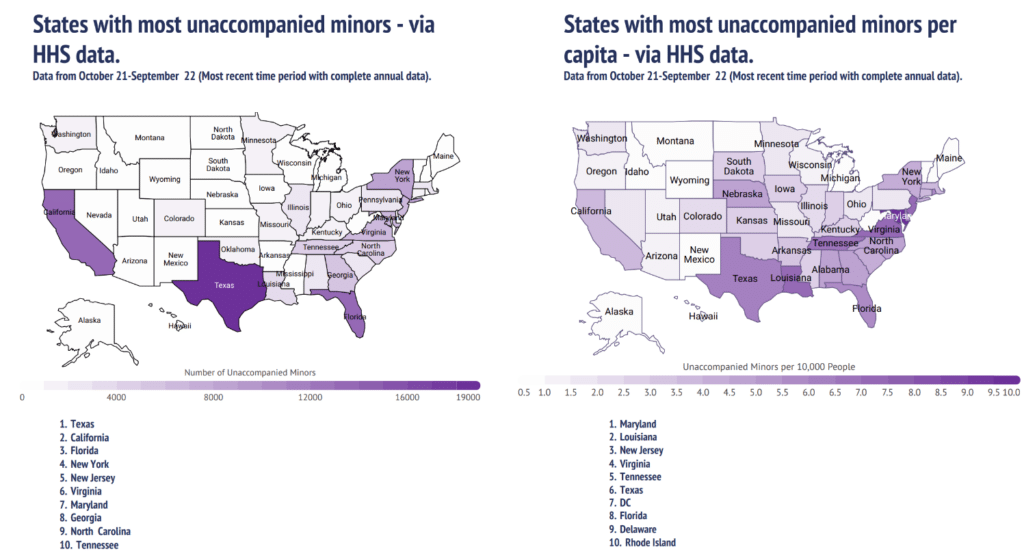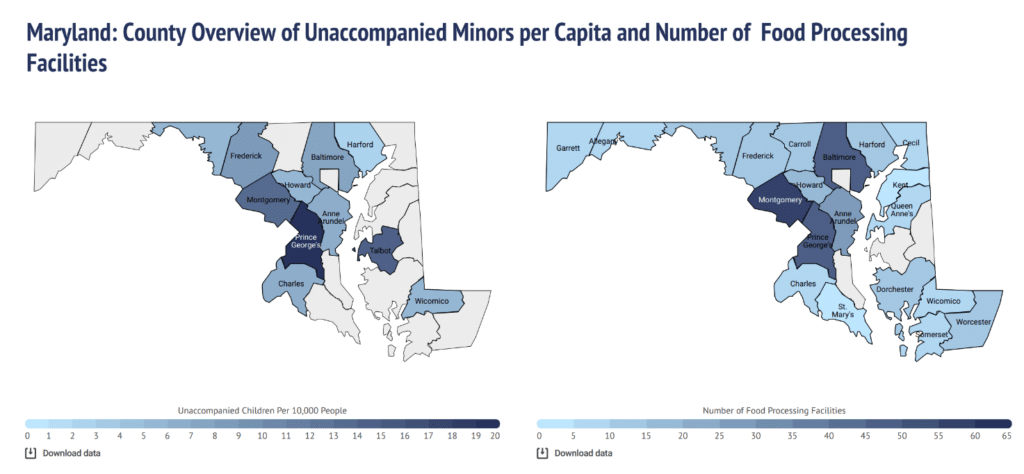
Credit: Chokchai Poomichaiya, Shutterstock
A widely read New York Times article on child labor by unaccompanied child migrants, published in February 2023, detailed the way that young people fleeing economic and political crises in Central America have collided with the tight US labor market and inadequate US labor law enforcement to create a “perfect storm” for child exploitation in the United States. The NYT found that unaccompanied migrant children seeking refuge in the US are placed by officials to live with “sponsors” to whom they may have little or no connection, and who in some cases act as labor recruiters or traffickers, reaching out to young people while they are still in their home country with the promise of work and educational opportunities. Once they arrive, migrant children face pressure to find work to pay off migration-related debt and send money home to their families. The NYT reported that the children are often hired in dangerous industries such as food processing, janitorial work, construction, and manufacturing – jobs that may violate their fundamental human rights and US labor laws, posing them significant health and safety risks, preventing them from attending school, and cutting into their time for sleep, studying, and play.
Three key steps in understanding a company’s risk exposure
Because the New York Times reporting found children working in multiple sectors and states across the country, no industry or state can be assumed to be free of child labor risk. One urgent need for companies operating and sourcing in the United States, therefore, is to understand where risk is likely to be highest, so they can prioritize and target on-the-ground assessments and other oversight efforts.
Verite recommends three key steps for companies seeking to understand their risk exposure:
- Mapping and identifying US facilities and worksites, both within the company’s own operations and in their extended supply chains. For this initial mapping and prioritization exercise, companies should know at a minimum:
- Location of each worksite (which may be different from parent company or headquarters address). In some cases, a single supplier or facility may have multiple satellite workplaces.
- Types of work processes performed at each site or facility.
- It is also important to know which facilities use outsourced labor or service providers and which job functions routinely use temporary workers or workers not directly hired by the facility. However, it is possible to conduct a preliminary risk analysis without this information, which may take additional time to collect.
- An analysis of risk factors that increase the likelihood of child labor by unaccompanied minors in the states and/or counties of each worksite in their US supply chain. Companies can conduct this analysis using publicly available data through a process described below.
- Comparison between locations of company and supplier worksites with a list of geographies with heightened risk, prioritizing worksites where most work is considered less desirable, hazardous, or “lower skilled.”
Understanding the geographic distribution of child labor risk
To assist in understanding the distribution of child labor risk in the United States, Verité’s Applied Research practice group has carried out a series of rapid geographic risk analyses, drawing on publicly available data sets linked to below. Please monitor verite.org for additional updates on this ongoing research in the coming weeks.
As a first step, we used data from the U.S. Department of Health and Human Services to map the absolute number of unaccompanied children (UC) released to sponsors by US state and county. Then, to better understand where there are concentrations of UC released to sponsors, we also looked at the number of UC per capita, dividing the absolute number of UC by state and county population data.

To identify areas in the US with significant numbers of UC that are also major centers for industries specifically noted in the NYT article, we used the US Census Bureau’s County Business Patterns database, running queries using various North American Industry Classification System (NAICS) industry codes to pull data on the number of establishments in various sectors, sub-sectors, and/or industries at the county level.
This enabled us to compare the county-level data on the number of UC per capita with county-level data on the number of establishments by industry, helping to visualize where there are both relatively high densities of UC and high numbers of establishments in particular industries. For example, these maps reveal the overlap between density of unaccompanied minors and the distribution of food processing facilities in Maryland:

Use of local labor force data from the US Chamber of Commerce (CoC) allowed Verité to factor geographic variations in adult labor scarcity into our analysis of child labor risk as well, which is important since locales lacking sufficient adult workers to fill open positions may also be locales where employers are more willing to overlook age verification or employ children in jobs typically held by adults to meet labor needs. The US CoC “Available Worker Ratio” for each state helped identify counties that both have high concentrations of UC per 10,000 people and are located in states experiencing heightened labor shortage relative to the national average ratio of job seekers to job openings.
Such data-driven risk modeling can help companies make fast and sensible decisions about how to prioritize next steps in combatting the exploitation of vulnerable children in their operations and supply chains. However, the sort of rapid geographic risk assessment being carried out by Verité is only a first step for companies that wish to mitigate risks for children in the US. There are other important risk factors to consider – not least differences in individual state child labor laws and recent political efforts to roll back legal protections for child workers in some states. Companies must of course also thoroughly map their product supply chains and labor supply chains to know how to apply geographical risk information.
At Verité, we regularly work with companies to build robust due diligence systems to prevent labor abuses such as child labor in their operations and supply chains around the world. Guidance such as these recommendations shared by Fair Labor Association reminds companies that the basic framework for decreasing the risk of illegal child labor in global supply chains applies equally in the US context.
FLA Guidance on preventing child labor in supply chains for companies:
- Commit to aligning policies with international standards on child labor even for workplaces in countries like the US that have not ratified core international child labor standards such as ILO ILO Convention 138 on minimum age and ILO Convention 182 on the worst forms of child labor;
- Recognize that local laws may not adequately protect children, so where local laws are weak or have gaps, companies should set, communicate, and enforce more stringent protections;
- Build awareness among staff, subcontractors, and supply chain partners on topics including minimum age for employment, minimum age to engage in different types of workplace tasks, and the prohibition on hazardous work for anyone under 18;
- Actively monitor facilities, prioritizing use of culturally competent monitors and listening to workers’ experiences directly, using worker’s and children’s experiences to inform any necessary remediation;
- Maintain required permits and parental consent documentation;
- Develop special considerations for the employment of young workers, to ensure adequate protections for young people over the minimum age of employment but under 18;
- Implement a system to identify and document proof of age for young workers; and
- Take steps for remediation and case management, developing systems in collaboration with appropriate social service agencies that place the wellbeing of working children first and strive not to perpetrate further harm.
(Adapted from Fair Labor Association, Preventing child labor in supply chains: Guidance for companies, March 8, 2023. https://www.fairlabor.org/preventing-child-labor-in-supply-chains-guidance-for-companies/)